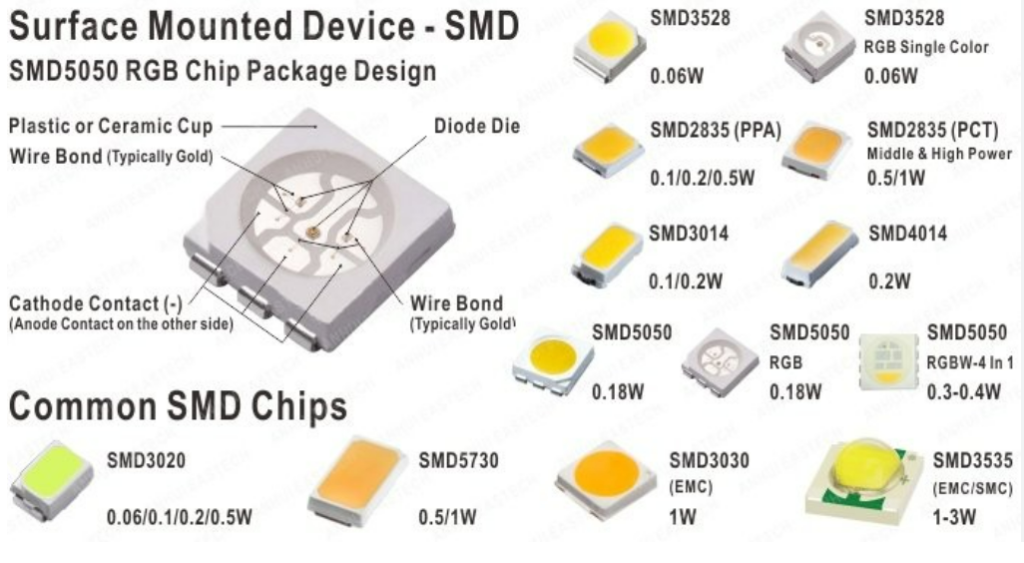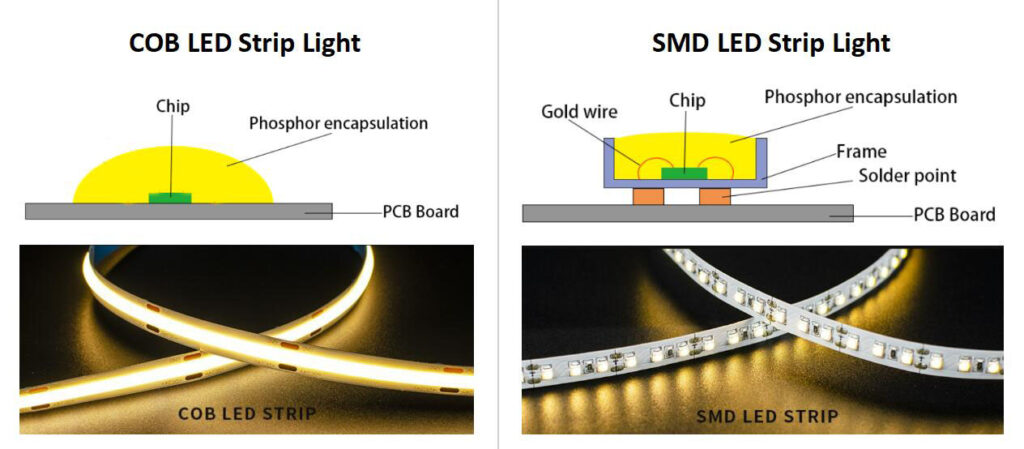What’s the real difference between SMD and COB LED lights? Choosing the right type of lighting is crucial to achieving the best results in any lighting project. Both SMD and COB LED technologies have distinct advantages, so understanding them will help you make the most suitable choice.

SMD (Surface-Mounted Diode) and COB (Chip on Board) are two of the most popular LED technologies today, differing significantly in brightness, power efficiency, and application scenarios. SMD LED strips offer flexibility and versatility, while COB LED strips are known for their high brightness and uniform light. Knowing the differences will allow you to select the right LED solution for your specific needs.
Whether you are a contractor, designer, or buyer, knowing the distinctions between SMD and COB LEDs can have a significant impact on the outcome of your projects. Let’s delve into each type’s advantages, brightness, applications, and potential drawbacks to help you choose the ideal LED lighting solution.
What is SMD LED, and What Are Its Advantages?

SMD LED (Surface-Mounted Diode) integrates multiple LED chips into a single package, making it ideal for flexible applications like LED strips. With multiple chips in each diode, SMD LEDs can deliver color variation and adjustable lighting effects, which makes them popular in dynamic lighting applications such as interior décor, ambient lighting, and advertising displays.
The main advantages of SMD LEDs are high brightness, ease of installation, and efficient heat dissipation. Additionally, SMD LEDs are well-suited to smaller spaces due to their moderate brightness per chip, making them ideal for even, subtle lighting effects. If you’re looking for customizable and flexible lighting solutions, SMD LED is a great choice.
What is COB LED, and What Are Its Advantages?

COB LED (Chip on Board) packs multiple LED chips into a single, dense light source, resulting in a uniform, intense beam of light. Due to this integrated design, COB LEDs deliver higher brightness and light intensity than SMD, making them ideal for applications that require focused, powerful lighting.
The benefits of COB LEDs lie in their high light density, which provides bright and evenly distributed light, making them well-suited for workspaces, industrial lighting, and outdoor signage. In a “COB vs. SMD brightness” comparison, COB LEDs typically outperform SMD LEDs, especially in environments where concentrated illumination is necessary.
Which LED is Better, SMD or COB?

Choosing between SMD and COB depends on the specific requirements of your project. For applications needing flexible installation or color-changing effects, SMD LEDs are usually a better choice. Meanwhile, for high-brightness, uniform light sources, COB LEDs excel. For example, in the “COB vs. SMD LED strip” comparison, SMD LED strips are preferred for residential decor or creative lighting effects, whereas COB LED strips provide superior performance in focused lighting applications.
What’s the Difference in Brightness Between SMD and COB?
The “COB vs. SMD brightness” question is common, especially for high-lumen applications. COB LEDs, with their integrated packaging and high light density, generally offer higher brightness and produce uniform light without dark spots. This makes COB ideal for industrial and large-scale indoor lighting applications. SMD LEDs, with their dispersed chip design, may offer lower brightness per unit but allow increased brightness by adding more chips, making them well-suited to decorative or adjustable lighting needs.
What Are the Disadvantages of SMD LEDs?
Despite their flexibility, SMD LEDs face challenges in high-power applications due to heat dissipation limitations. Excessive heat over prolonged use may reduce brightness or affect longevity. Furthermore, some SMD models may lack sufficient brightness for larger spaces compared to COB LEDs. Additionally, SMD LED strips may create visible light spots in some applications, which could be undesirable in settings requiring seamless lighting.
Which SMD LED is the Brightest?
Among SMD models, 5050 and 5730 LEDs are known for their brightness. The 5050 SMD LED offers high brightness and energy efficiency, making it popular for both home and commercial lighting, while the 5730 SMD, with a higher power rating per chip, performs well in applications requiring extra brightness. Choosing a brighter SMD model can help achieve effective decorative or task lighting.
What Are the Disadvantages of COB LEDs?
COB LEDs, while extremely bright, are less versatile in certain scenarios. Due to their integrated design, COB LED strips can be challenging to cut and install, making them less suitable for projects that need customized lengths or more complex layouts. Additionally, COB LEDs generate substantial heat, sometimes requiring additional heat dissipation mechanisms, which can raise costs in smaller installations. Thus, in the “COB vs. SMD LED strip” comparison, SMD often wins in terms of flexibility.
Conclusion
Both SMD and COB LEDs have unique strengths: SMD offers design flexibility, while COB is ideal for high-brightness, uniform illumination. When choosing an LED light source, it’s essential to consider your specific brightness, heat dissipation, installation, and budget needs for the best lighting results.







